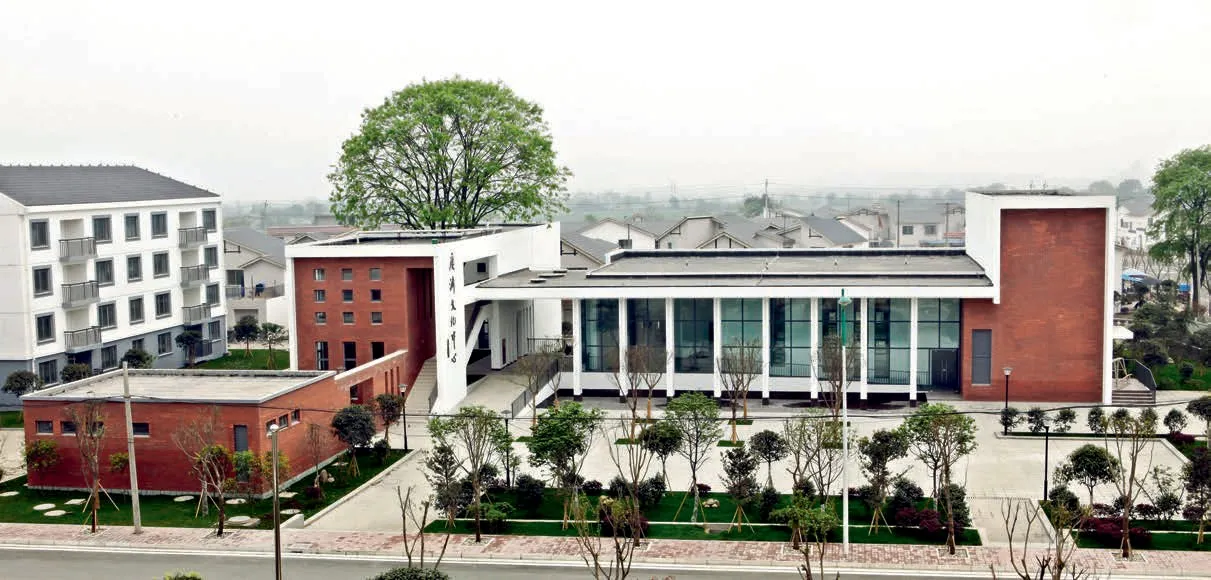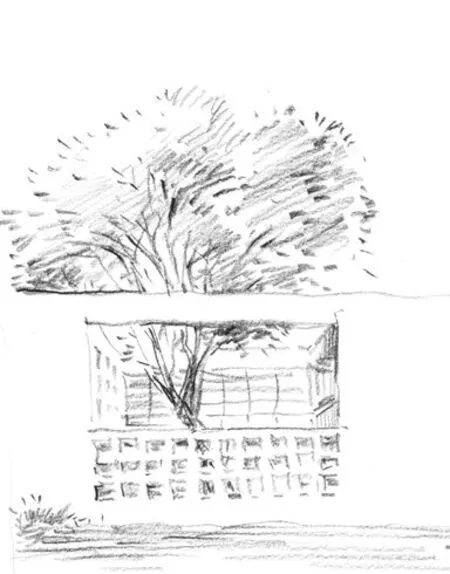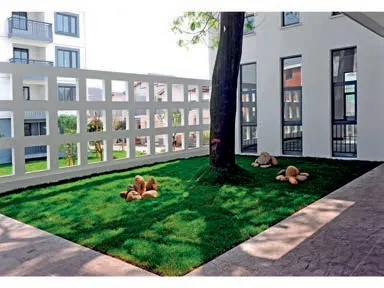广济镇文化中心,绵竹,中国
2021-10-27王建国,徐小东,王鹏等
绵竹市广济镇位于绵竹市西部,北依龙门山脉,在5·12特大地震中人员伤亡、房屋损毁惨重。由东南大学建筑学院和建筑设计研究院进行设计的灾后重建公共建筑群集中位于镇区中心的4个地块内,包括文化中心、便民服务中心、卫生院、小学校、幼儿园、福利院等公共民生设施。
文化中心是第二批援建项目之一。建筑布局充分考虑当地气候条件,采用规整平面形式,利用地形和植被加以限定,形成尺度适宜、层次丰富的建筑空间。建筑造型一方面保证功能空间表达的真实性,另一方面,在立面柱廊、开窗形式和材料划分等细节的艺术处理上考虑了与文化中心功能相关联的节律性视感。庭院设计结合地震中幸存的大树,表达特有的场所价值。以功能实用和经济性为前提,设计采用通用建材和构造节点,方便施工和工程进度把握,同时保证建筑良好的自然通风采光性能。
建筑用色主要有3种,墙柱形态结构性构件采用白色涂料,水刷石墙面采用灰色,填充墙体的面砖则选用了土红色面砖,色彩搭配协调中而有对比变化,试图营造震后重建家园的几许温馨,缓解灾难之后民众的伤感。□
项目信息/Credits and Data
设计团队/Design Team: 王建国,徐小东,王鹏,孙海霆等/WANG Jianguo, XU Xiaodong, WANG Peng, SUN Haiting, et al.
建筑面积/Floor Area: 936 m2
设计时间/Design Time: 2009
竣工时间/Completion Time: 2010
摄影/Photos: 王建国,盛雪东,孙海霆/WANG Jianguo,SHENG Xuedong, SUN Haiting

1 东南外景/Southeast exterior view(摄影/Photo: 盛雪东/SHENG Xuedong)

2 鸟瞰/Aerial view(摄影/Photo: 王建国/WANG Jianguo)

3 草图/Sketch
Guangji Town is located in the western part of Mianzhu City, with the Longmen Mountains to the north. In the major earthquake on 12th May,2018, the town suffered heavily from numerous causality and damages to buildings. The public building complex reconstructed after the earthquake is located within four sections of the central town area, including public facilities as cultural centre,convenience centre, health centre, primary school and secondary school, kindergarten, welfare homes, etc.
The cultural centre is among the second batch of reconstructed projects. Local climatic conditions were carefully considered in the building layout.The regular plan was applied, defined with terrain and vegetation, shaping the architectural spaces with appropriate scale and diversified hierarchy. In terms of architectural forms, on the one hand, the authenticity of functional spaces was expressed; on the other hand, the visual rhythm that related to the functions of cultural centre was considered in the artistic articulation of the portico on façades, forms of openings and subdivision of materials. Trees that survived the earthquake were integrated in the design of courtyards, presenting the particular value of locality. On the premise of practicability and economy of functions, general building materials and construction details were applied in the design,facilitating the construction and the control of project progress and meanwhile assuring adequate natural ventilation and lighting performance of the building.
There are three colours applied on the building.White paint was applied on the structural elements of walls and columns. Grey was applied on the granitic plaster walls. Earth-red bricks were chosen for the block walls. This colour palette was designed to add contrast to the overall harmony, as an attempt to create a warm atmosphere for the rebuilt homeland , relieving the pains that the general public suffered after the disaster.□
评论
张彤:广济镇文化中心是汶川地震广济镇灾后重建的援建工程之一。这项工作的特殊性不仅在于灾后重建的紧迫性和对建设质量的高要求,一个乡镇的重建,从总体规划到建筑设计,以至市镇空间和室内设计基本上由一个团队完成,这在汶川地震的灾后重建中并不多见。
项目团队运用城市设计的方法,对镇区中心的4个街区进行了市镇设计,包括细化地块划分、明确体量和空间关系、确定机动车出入口、控制连续街墙和协调建筑风格和材料做法。街区设计明确划定了溪流两侧的公共绿地,在镇中心十字路口周围设置广场,营造市镇公共空间。这个附加的环节让我们认识到,城市设计不只是针对城市的设计,而是一种兼顾整体性、关联性和空间性的工作方法。这使得重建后的广济镇保留了乡土气息显著的市镇空间特征,成为绵竹市各重建乡镇中最具整体质量的范例。
广济镇文化中心位于四街区中心的东南象限,建筑的形体和空间组织是在市镇设计框架下由外及内的过程。观演厅的主体量与北侧便民服务中心相对应,两者之间是市镇中心的公共广场。在面向广场的一面,文化中心设置了通高柱廊,显现出乡镇环境中少有的公共性。东侧的3个小体块由连续街墙统领,围合中心广场。体块布置小心地保留了镇区中心最大的一棵树,它在地震中屹立不倒,成为生命和希望的象征。

4 首层平面/Ground floor plan

5 庭园局部/Partial view of the garden(摄影/Photo: 孙海霆/SUN Haiting)

6 庭园局部/Partial view of the garden

7 柱廊与倒影池/Portico and pool(6.7 摄影/Photos: 盛雪东/SHENG Xuedong)

8 外景/Exterior view(摄影/Photo: 孙海霆/SUN Haiting)

9.10 剖面/Sections
Comments
ZHANG Tong: This Cultural Centre is one of the aid projects for the reconstruction of Guangji Town after the Wenchuan Earthquake. The particularity of this work lies not only in the urgency of postdisaster reconstruction and the high requirements for construction quality. Moreover, the reconstruction of a town, from the master plan and the architectural design to the town's space and interior design, is basically completed by one team. This is not common in the postdisaster reconstruction of the Wenchuan Earthquake.
The project team used urban design methods to design the four blocks in the centre of the town,including detailed plot division, clarification of volume and spatial relationship, determination of vehicle entrances and exits, and control of continuous street walls as well as the practice of coordinating architectural styles and materials. The block design clearly delineates the public green space on both sides of the stream, and a square is set around the crossroads in the town centre to create a public space. This active participation has made us realise that urban design is not just a city design, but a holistic, connected and spatial working method. This makes the rebuilt Guangji Town possess the distinctive characteristics of the town space that retains rustic flavour, and it has become an example of the highest overall quality among the rebuilt villages in Mianzhu City.
The Cultural Centre is located in the southeast quadrant of the four-block centre. The physical and spatial organisation of the building is an outside-toinside process under the framework of the town design.The main volume of the auditorium corresponds to the convenience service centre on the north side, and the public square in the centre of the town lays between the above two. On the side facing the square, the Cultural Centre has typologically set up high colonnades,showing the rare publicity in the village and town environment. The three small volumes on the east side are dominated by continuous street walls, enclosing the central square. They carefully preserve the largest tree in the town centre, which survived the earthquake and became a symbol of life and hope.
